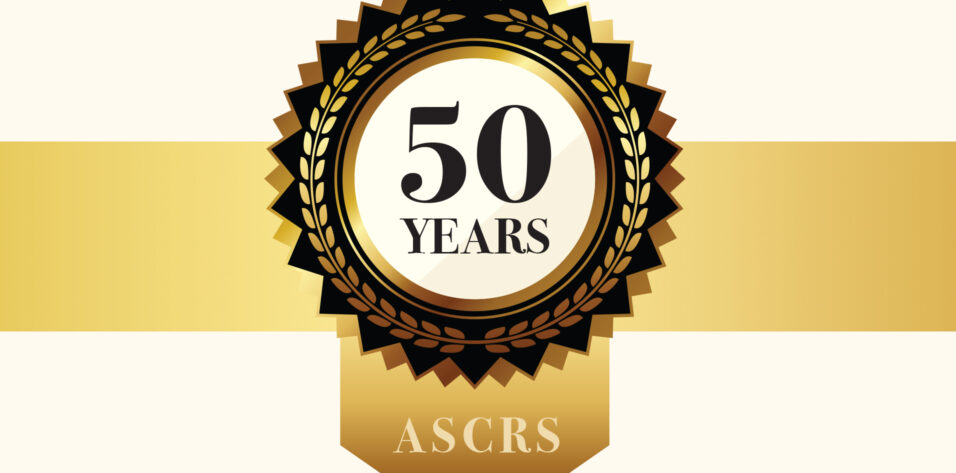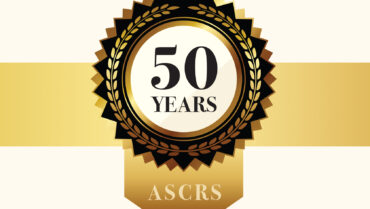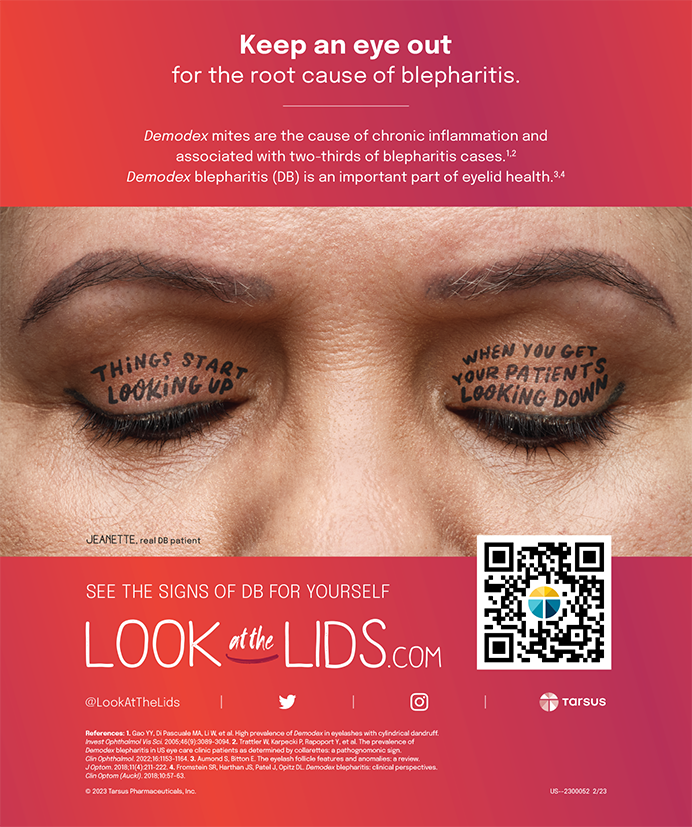To commemorate the 50th anniversary of the ASCRS, CRST’s editors dug into the archives for this article on the organization’s founding from the publication’s March 2004 edition.
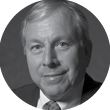
Influenced during my residency by an article1 on the cases of Cornelius Binkhorst, MD, I was already interested in IOLs when I started my private practice in Santa Monica, California, in 1972. I planned to implant my first IOL in March 1974, but my mother unexpectedly died on March 16 at the age of 57. Her death was a devastating blow to me at 30 years of age, and I put everything else in my life on hold. While in mourning, I identified four major actions I felt compelled to take in her honor: (1) start a course to teach lens implant surgery; (2) found a peer-reviewed journal for lens implant surgery; (3) bring to the United States some Europeans’ methods for IOL power calculation; and (4) most importantly, unify US surgeons performing lens implantation by organizing a national lens implant society that would hold scientific meetings. One month later on April 22, 1974, I implanted my first IOL.
In those days, any novice could implant lenses without restrictions, but surgeons had nowhere to turn for help. There were no meetings, journal articles, or scientifically established facts. Implants were controversial, and the IOL pioneers themselves were a divided lot. Historically, “big names” in the field founded medical organizations. The problem involved in creating a lens implant society was that many of the well-known surgeons did not get along. Because it seemed unlikely that a single pioneer was planning or would be able to launch such a society, I theorized that an “unknown” with whom no one had any personal differences might be more successful.
THE BEGINNING OF THE AMERICAN INTRA-OCULAR IMPLANT SOCIETY
I asked three of my local colleagues—Drs. Jeremy Levenson, John Darin, and Steven Cooperman—to join me in planning and pursuing my idea for an implant society. The four of us formed the first executive committee. I chose the society’s name and thought the central IOI of its acronym, AIOIS, would become the term used for lens implants. The term IOL caught on instead.
Despite our collective lack of name recognition, my colleagues and I convinced 13 well-respected implant surgeons to serve on a scientific advisory board (SAB) for an organization of which they had never heard. They were Drs. Ralph Anderson, Ronald Barnet, Robert Drews, Miles Galin, Turgut Hamdi, Francis Hertzog Jr, Henry Hirschman, Norman Jaffe, Richard Kratz, James Little, Dennis Shepard, Bradley Straatsma, and Murry Weber.
Our next step was to make a public call for membership. We agreed on an invitation letter that described our plans to sponsor a meeting and scientific journal as well as a national implant pathology registry, which was a pet project of mine. We set membership dues at $25, with a one-time opportunity to become a founding member for $100. I remember sitting on my living room floor, applying each mailing label, and folding and inserting the letters. By 1975, the AIOIS membership totaled 633. With the help of my brother, Gary, AIOIS was the first medical society to have its membership list computerized in-house (a decade before the first, commercial personal computer). I established an honorary membership, and the SAB later conferred that status on Drs. Harold Ridley, Cornelius Binkhorst, Peter Choyce, Edward Epstein, Svyatoslav Fyodorov, Warren Reese, and Benedetto Strampelli.
THE FIRST SAB MEETING
At the 1974 AAO annual meeting, members of the AIOIS’ executive committee and SAB met each other for the first time. Being very shy, I was extremely nervous about meeting these cataract surgery icons and pioneers. I must admit that the thought of my mother gave me the courage to enter the room that evening. I introduced myself and presented all of the work we had done for their evaluation and approval. The SAB approved the name, logo, and designs, although Dr. Drews correctly pointed out that I had given them little choice. In truth, I had not wanted a committee to direct the society’s organization at this crucial stage.
Dr. Hirschman had previously planned an informal get-together for the alumni of his IOL course at the same hotel the next day. Somehow, word got out that this gathering was a meeting of our new implant society, and attendants packed the room and overflowed into the hallway. I fought my way through the crowd, because Dr. Hirschman had asked me to discuss the AIOIS. It was at this time that I first publicly announced the formation of the society.
In early 1975, our SAB met again in Santa Monica (Figure 1). The rumblings of the FDA loomed on the horizon and threatened to end IOL implantation in the United States. Soon afterward, several leaders of the Contact Lens Association of Ophthalmology tried hard to persuade our SAB members to combine our two organizations. After heavy politicking, this move was fortunately prevented and ultimately voted down.

Figure 1. The first three presidents of AIOIS worked together at the 1975 SAB meeting (from left to right: Robert Drews, MD [1977 to 1979], Norman Jaffe, MD [1975 to 1977], and the author [1974 to 1975]).
THE JOURNAL
From very early on, I had wanted to start a scientific journal under the auspices of the AIOIS. Our SAB initially rejected this idea as premature and expensive. Instead, in May 1975, I published the first issue of the AIOIS Newsletter. The premier issue contained a single scientific article2 that I had written entitled, “Mathematics & Computers in IOL Power Calculation.” We printed and mailed the newsletter to 12,000 ophthalmologists. For the second issue in September, I was able to cajole others into writing articles. The issue had 11 scientific articles,3 and, with no experience, I became a journal editor under fire.
Upon seeing the second issue, our SAB was impressed that we had something more than a simple newsletter. Dr. Hirschman held up the issue at the SAB meeting and said, “Now this is a journal!” The board then approved the AIOIS’ having a journal and the funds for a full-scale launch. I was Scientific Editor as well as Managing Editor, and I spent many late nights physically cutting and pasting material to send to the printer. I also conducted a survey by mail of the membership’s preferences in cataract and lens implant surgery and published the results in Ophthalmology.4 David Leaming later restarted surveying our membership and now handles this large survey on an annual basis.
Our publication improved after we persuaded Dr. Drews to become Scientific Editor in January 1977. I continued as Managing Editor until 1980. Over the years, the publication’s frequency increased from quarterly to bimonthly (1985) to monthly (1998). It eventually merged with the similar journal published by the ESCRS (1996). The Journal of Cataract & Refractive Surgery (née the AIOIS Journal) has become the most widely read and influential journal on the subject in the world. I will always be grateful to the successive editors Drs. Drews (1977 to 1978), Henry Clayman (1978 to 1980), Stephen Obstbaum (1981 to 2001), and Emanual Rosen (present) for helping to make the Journal of Cataract & Refractive Surgery the accomplishment of which I am the most proud.
ASCRS SPRING SCIENTIFIC SYMPOSIUM
Meetings. After much wrangling, my plans for a scientific meeting were approved by the SAB. Our inaugural symposium was held in Dallas on September 21, 1975, the day before the AAO Annual Meeting. The following year, we held our symposium in Los Angeles in conjunction with the International Intraocular Implant Club meeting. I selected the Century Plaza Hotel because of its proximity to Santa Monica. The hotel’s event manager at that time was David Karcher. Although he was initially leery of working with our fledgling society, I convinced Mr. Karcher that I could fill his hotel. In the end, he was very helpful in making this meeting successful. With the assistance of Dr. John McTigue, I enlisted Bob Hope as our entertainment for the Gala Dinner.
The second meeting was such a success that we decided from then on to hold our main meeting in the springtime, independently of the AAO. We returned to the Century Plaza as the US IOL Symposium in 1978 with comedian George Gobel and Charles Kelman, MD, as our entertainment. We invited exhibitors for the first time and permitted the corporate sponsorship of receptions. My nurse, Pat Thirsk, RN, was the first chairperson of the nurses and technicians program, which I instituted that year. The first video program, which was rather crude, also debuted. It later became the film festival, thanks to Drs. Dennis Shepard and Spencer Thornton (Figure 2).
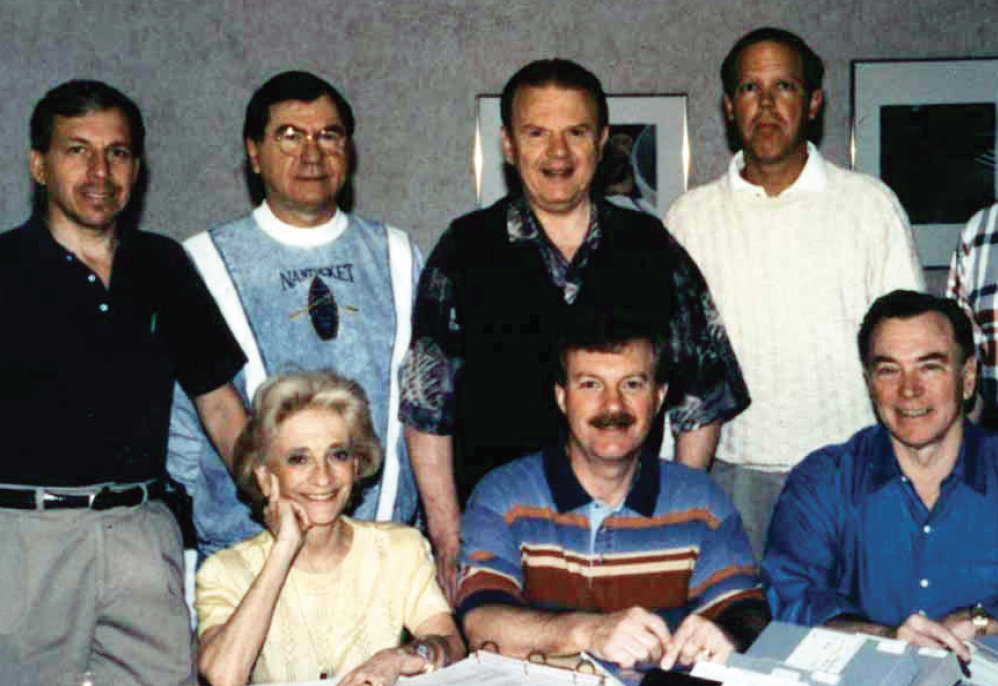
Figure 2. The 1994 Film Festival judges appear together (standing, from left to right: the author; David Langerman, MD; Dennis Shepard, MD; and James Davison, MD; seated, from left to right: Danièle Aron Rosa, MD; Robert Fenzyl, MD; Spencer Thornton, MD, FACS).
I do not think the excitement of those days can be duplicated. As Dr. Kelman said to an audience at the 100th anniversary of the AAO in 1996 when commenting on my presentation about the history of the ASCRS, “Those were the days my friend, we thought they’d never end.” The AIOIS meetings took place every year at the Century Plaza Hotel until the mid-1980s when they outgrew the hotel’s capacity.
Awards. The AIOIS instituted the Innovation Awards and presented them to Drs. Hirschman (for his IOL-positioning spatula), Kratz (for his posterior capsule polisher) and John Sheets (for his Sheets IOL glide). These awards were discontinued after 1980 but were later resurrected as the Innovator’s Lecture, now named in honor of Dr. Kelman. The AIOIS also formed the first manufacturer’s panel to deal with issues such as problematic anterior chamber IOLs. Interest in IOLs was so great that we scheduled symposia late into the evenings with overflowing attendance.
Additionally, the AIOIS established a named lecture in honor of Dr. Binkhorst. He himself presented the first Binkhorst Medal Lecture at our inaugural meeting. Subsequent presenters were Dr. Jan Worst and Dr. Jaffe. To my great surprise, I was asked to give the lecture in 1997.
I decided that the AIOIS should honor Dr. Ridley in 1979 on the 30th anniversary of his first lens implantation with a large book filled with signatures of appreciative IOL surgeons from around the world (Figure 3). When I visited Dr. Ridley’s home in the summer of 1999, I found the book sitting on a table in his living room. Perusing it 20 years later certainly made me feel my age.
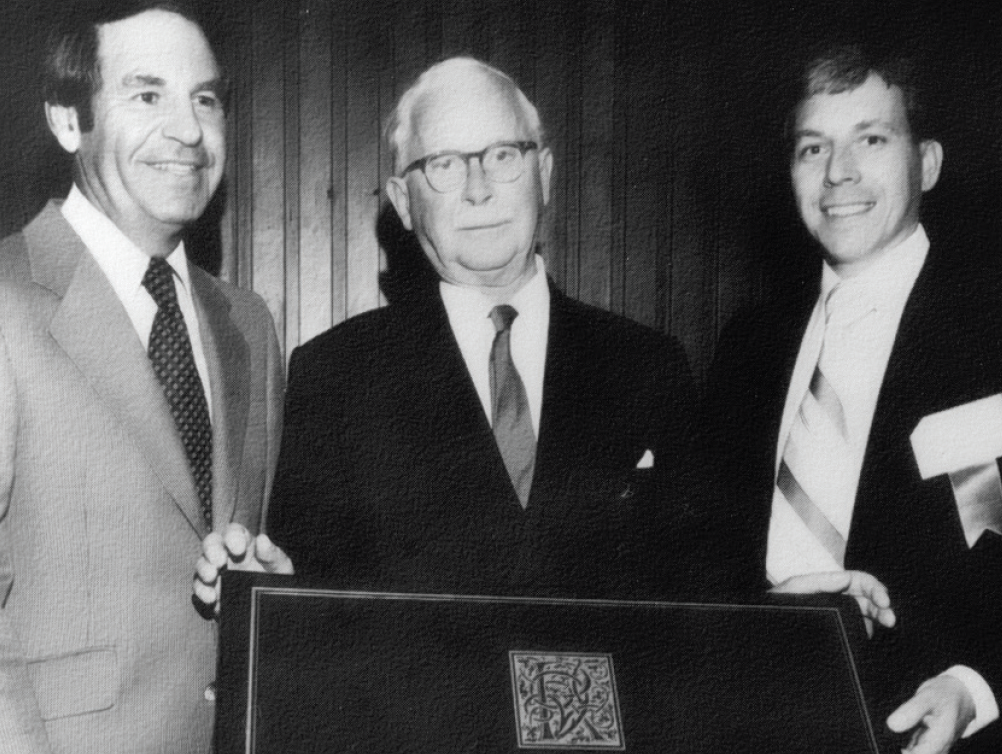
Figure 3. In 1979, Norman Jaffe, MD (left), and the author (right) presented an album to Sir Harold Ridley (center) in celebration of the 30th anniversary of his first lens implantation.
RETIREMENT
The first office for the AIOIS was in my Eye Lab at Santa Monica Hospital but later moved to my practice office. In 1977, the office relocated to separate quarters in my building until its final move in 1981 to Fairfax, Virginia.
I was exhausted by 1980 after devoting my life to the AIOIS for 6 years. With three young children to raise and a solo practice needing my attention, I retired from all of my roles in the society. In my resignation letter, I recommended that our SAB replace me with Manus Kraff, MD, as chairman of the scientific meetings. He has ably performed this job for more than 20 years. Ironically, Mr. Karcher filled my role as secretary when he was later chosen as the society’s executive director. I recommended Dr. Obstbaum as journal editor, and he did an outstanding job for 20 years as well.
It is now 30 years since I first dreamed up the idea for an implant society. As I reflect upon its history, annual symposium, and journal, I think my mother would be proud.
1. Pearce JL. Long-term results of the Binkhorst iris clip lens in senile cataract. Br J Ophthalmol. 1972;56:319-331.
2. Hoffer KJ. Mathematics and computers in intraocular lens calculation. Am Intra-Ocular Implant Soc J. 1975;1(1).
3. Hoffer KJ. Selection of lens power for implantation in infants and children. Am Intra-Ocular Implant Soc J. 1975;1:2:49.
4. Hoffer KJ. Survey on the use of intraocular lenses. Ophthalmology. 1978;85:400.

